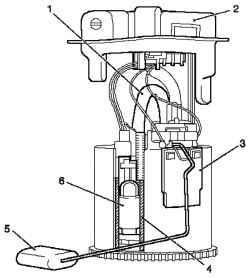1. Using a steel brush, remove the pipe cover the length of 6,5 mm from the end, which will be laminated. 2. Clamp the brake lines to adjust for the 5 mm brake lines. 3. Use a tool for expanding (E or F) for the brake lines with a diameter 4,75 mm. Expanding the type F - I. Capture (Workholding, 5 mm). Brake line with expanding type F. Tool for expanding the type F (4,75 mm). Expanding the type E - II. Capture (Workholding, 5 mm). Tool for expanding the type E (4.75 mm). Brake lines with expanding the type E.
The main brake cylinder Brakes new master cylinder and new brake booster Fig. 6.2. General view of the tandem master brake cylinder: 1 socket compensating reservoir, 2 building a tandem master brake cylinder type, and 3 - the primary piston (piston pusher), 4 - sealing sleeve of the primary circuit; 5 compression springs, 6 - secondary piston (floating piston ) 7 - sealing sleeve in the secondary circuit, 8return spring
Restrictions on the size marker in all models of Astra-H engine Z19DTH and Zafira to the left-hand steering led to the need to design new, more compact master brake cylinder. Effect of this tandem cylinder based on the principle of "plunger".
Unlike conventional master brake cylinder, sealing plugs are embedded in the body instead of being installed on the piston, as before. The hole in the hull, thus directly sends pistons. This design reduces the length of the tandem master brake cylinder by 25%. In addition, the number of nodes is reduced to 15, thus significantly lowered weight, reduced size and length of service. Fig. 6.3. The scheme of the master brake cylinder in a free state and after a free running: I - tandem master cylinder in a free state; II Tandem master cylinder after free running; 1 - sleeve sealing 2 - ring groove 3 - primary or secondary piston; 4 - hole in the piston
"Plunger" tandem master cylinder like the 2nd generation, like almost all the brake cylinders, provides the dual-circuit brake system. Contours of pressure are consistent. Force the driver is passed as usual, from the stock brake booster to the primary pistons. Creates a preliminary pressure of compression springs mounted on the end of the primary piston, and it provides a virtually simultaneous transfer efforts to the secondary piston (floating piston). Joint action of two pistons in one spring would reduce the free running and causes the secondary braking circuit to react more readily than it does in conventional tandem master cylinder.
In the system used to date the secondary piston is driven by the pressure in the primary circuit brake system. This leads to an increase in free running, because at first the pressure should increase up to
437














































































































